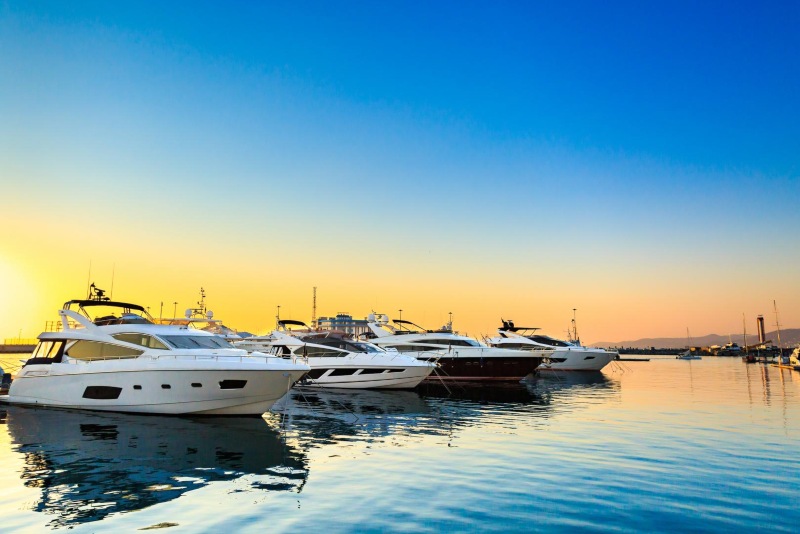Choice of Battery Packs
Why Lithium-Ion Battery Packs are the Best Choice for both New and Old Boats
There are hundreds of reasons to go boating. It could be a family tradition, fishing, camaraderie, sports, the fresh air, the scenery and that sense of freedom. No matter what your reasons are or your boat class1 is, you want to make sure you are fully equipped, and your boat is not going to run out of power on your next trip.
In a recent blog, we compared Lithium-Ion with Lead-Acid Battery packs. If you’ve been led to believe Lithium-Ion battery packs will cost you more, this article is recommended reading. It concludes that after considering all the factors of weight, maintenance, usable capacity, temperature, installation, safety, charging, discharging, life span, energy density, cost and environmental impact, the choice becomes clearer; and in favour of LiFePO4 (Lithium Iron Phosphate, LFP) batteries. Lithium-based batteries are quickly becoming a preferred replacement for the 150-year-old technology of Lead-Acid batteries.
Let’s look at some further marine power management systems.
Inverters
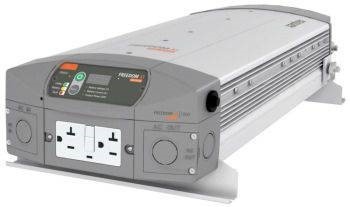
Inverters are required in marine vessels, typically for two reasons. Firstly, to convert the stored energy in the 12V, 24V, 36V or 48V marine battery bank to pure sine-wave 120V AC or 240V AC power (pure sine-wave makes it more efficient, allowing batteries to last longer). The AC power enables the use of common household appliances on a boat when onshore power is not available. Secondly, if you are plugged into shore power, the system will switch from using invertor AC power, to charging the vessel’s12V, 24V, 36V or 48V batteries. Sometimes battery banks of voltage higher than 48V are used. The inverter capacity and the type selected, will depend on what the unit is required to do.
The accompanying picture shows an example of an inverter/charger.
Marine Battery Types
There are three basic types of marine batteries:
- Starting Batteries provide quick but powerful spurts of energy over short periods of time and are designed to start the engine and be rapidly recharged by the engine(s) alternator(s). A starting battery should not be used for trolling motors2 or powering appliances.
- Deep Cycle Batteries are designed to discharge slowly over a long period of time and to withstand several hundred charge and discharge cycles. A deep cycle battery is the right choice for powering an electric trolling motor and other battery-powered accessories such as audio systems, a windlass, depth finders, fish locators, and appliances. Deep cycle batteries should not be substituted for starting batteries.
- Dual-Purpose Batteries combine the performance of both starting and deep cycle batteries; and are a good choice on smaller vessels, when there’s little room for two batteries. While they’re able to perform the tasks of a starting battery and deep cycle battery, they’re not as efficient as separate batteries.
Charging Options
While there are a number of Marine Battery Pack charging options, it is best to go for multi-sourcing, where possible.
Solar Sails and Panels
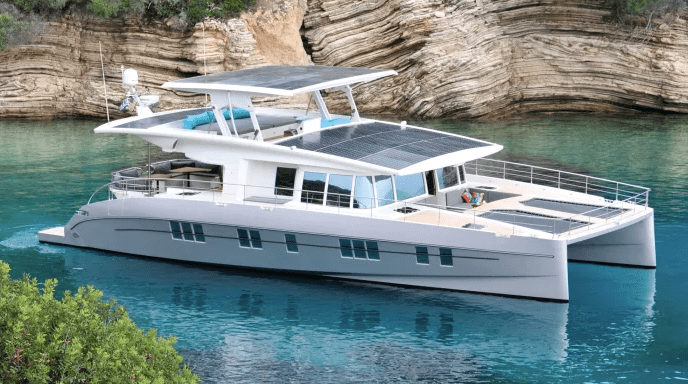

There are many boats that utilise solar power for partial or full power sourcing. A bank of solar panels is the most common, dependable source of charging power. The above catamarans with solar panels are an example of this. Although, they are the slowest charging source, once installed with their charge controller they do their job quietly, both on sunny and cloudy days. Imagine sitting in a fully electric boat, where the only sound you hear is the water and nature, around.
Looking at the solar sail picture above, it contains 2,500 solar panels (cells made from silicon) that can generate around 355 kWh of power, which in turn can be stored in a series of on-board batteries. On the practical side, the spinnaker is made of nylon and the mizzen staysail is made of Dacron because they must be light, handy and functional, to be easy to lift and then hauled down in the forepeaks.
Wind Generators
There are a number of incredible marine architectures designed to use wind power for a sustainable energy source. Wind generators are commonly used in 30 to 50 feet long vessels, for keeping up with a 24/7 The picture on the right, below, shows an example of these efforts, Charles-Henri Viel’s design in the Brittany South shipyard in Belz. The boat is 11 meters long, 6 meters wide and weighs 10 tonnes, built of aluminium, with a wind turbine of 6 meters diameter.
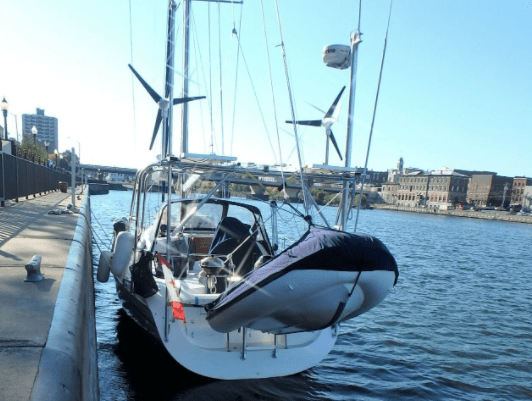

Wind generators are commonly used in 30 to 50 feet long vessels, for keeping up with 24/7 constant high-power demand, such as the fridge.
Hydro Generators
Today’s energy-intensive yachts, burn through hundreds of amp-hours of battery capacity each day, while the boat is sailing. Hydro generators are a great way to help top up the marine vessel battery banks. A hydro generator has an impeller (reverse prop) that rotates when towed behind a boat. AC power is produced as that rotation is applied to an alternator. The AC power is rectified to produce DC power to charge up the boat batteries.
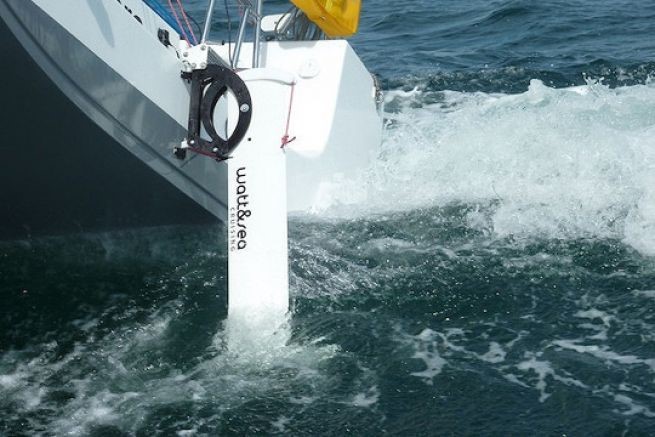
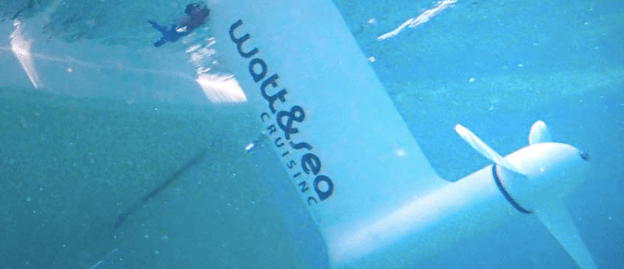
The water drag as well as seaweed caught in the propeller are issues to consider.
Alternator Charging
Marine alternators have more stringent requirements compared to their automobile equivalent. Their main features include:
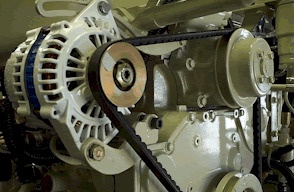
- Spark screens that meet U.S. Coast Guard standards, to eliminate the alternator as an ignition source
- Double-insulation, to eliminate electrical shock in wet conditions and prevent sparks
- Dual fans and large heat sinks for self-cooling under high, continuous loads
- Stainless steel bearings, corrosion-resistant metals and heavy-duty coatings
- High output at low RPMs to match marine diesel engine operating conditions
- Battery sensing regulators for high-efficiency battery charging and detection of battery cell failure.
Marine Alternator
While having a correct alternator output voltage is a very important part of your marine alternator choice; for charging your battery bank, having an external DC regulator (unless internal to the alternator’s design) is also vital to ensuring your batteries are being correctly and efficiently charged.
Hydrogen Powered Vessels
With marine power technologies advancing, much effort has gone into technologies that eliminate the use of fossil fuels, which cause major pollution in waters around the world.
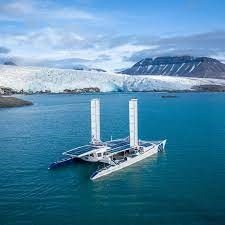
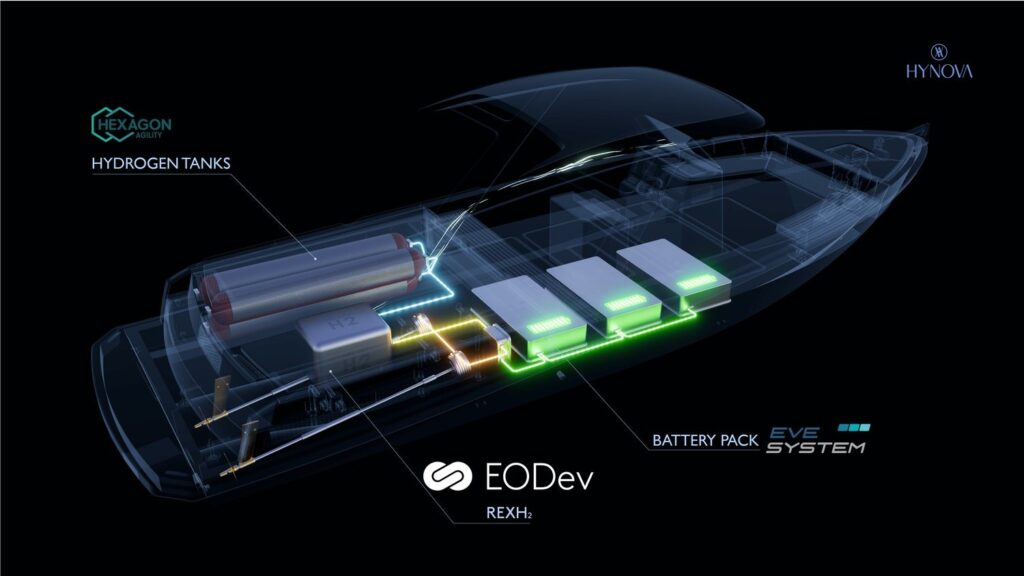
The Energy Observer cruise ship, developed by Victorien Erussard (shown below) and supported by Toyota, is an example of this approach. The Energy Observer set sail on a six-year world tour in 2017, testing new technologies, from onboard hydrogen electrolysis to fully-automated sails. One major flaw found was that it wasn’t possible to use seawater to generate the vessel’s own hydrogen, while at the sea. It had to dock to do that. This is because the electrolyser uses 25kW of energy, which is almost all of the boat’s total output of 28kW. To do this at sea, wouldn’t left enough power over to propel the boat, as well as keep the crew alive and warm.
Onshore Boat Charging Stations
One advantage of using an Onshore Power Supply (OPS) while your vessel has birthed at the marina, is to improve air quality in ports and port cities and reduce emissions of air pollutants and noise, and to a lesser extent, carbon dioxide. This is done by replacing onboard-generated power from diesel auxiliary engines, with electricity generated onshore. It is necessary to make sure the OPS provides the AC power you need. It will be either 120V AC or 240V AC, depending on your appliances. You also have to make sure you are following the latest isolation and ground faults regulations.
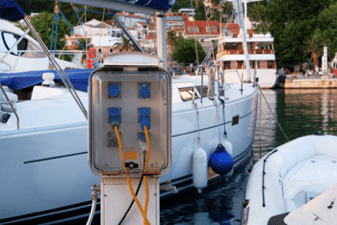
For your own safety, to prevent getting electric shocks in your boats, the American Boat and Yacht Council (ABYC) issues recommended standards for recreational boats, while the National Fire and Protection Association (NFPA) develops electrical standards known as NEC (National Electric Code). These standards are neither national, nor standard code—they are recommendations—and it is up to each state or locality to adopt them. ABYC focuses on your boat, while the NFPA has turned its attention to marinas. Over the last decade NFPA has been developing and implementing new standards to address the marina side of the issue, resulting in changes to dock pedestals that have created some confusion and frustration for boaters.
Boat Wiring
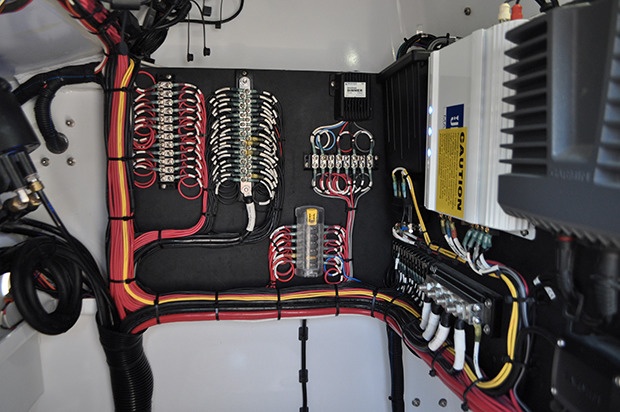
Any marine powering method requires a tidy and clean identifiable wiring and assembly, especially when it comes to doing any trouble shooting. It’s best if you use ABYC & NMEA 2000 certified technicians for your boat wiring.
Additional Notes:
1. Boats Classified
Boats according to their length are divided into four classes:
- Class A Vessels: These are less than 16 feet in length.
- Class I Vessels: These range from 16 feet to less than 26 feet in length.
- Class II Vessels: These range from 26 feet to less than 40 feet in length.
- Class III Vessels: These range from 40 feet to less than 65 feet in length.
Measuring Vessel length:
The length of these vessels are measured from the tip of the bow in a straight line to the stern. This does not include outboard motors, brackets, rudders, bow attachments, wake board towers or swim platforms and ladders that are not a molded part of the hull.
2. Trolling Motor
A trolling motor is a self-contained unit that includes an electric motor, propeller and controls, and is affixed to an angler’s boat, either at the bow or stern. A gasoline-powered outboard used in trolling, if it is not the vessel’s primary source of propulsion, may also be referred to as a trolling motor. Wikipedia
Trolling motors allow a boat to stay in one spot when fighting against current or wind without deploying a physical anchor. Tilt the outboard engine out of the water and use the trolling motor to explore areas that are otherwise too shallow to access.
Technology executive with an extensive track record in electronics, firmware and software development, production, business development, strategic planning and marketing, in the automotive, medical, aerospace, educational, IoT, and telecom fields. I have formed and led new companies and engineering departments, managing technology development programs and projects from initial concept right through to production. I have increased operational efficiencies through initiating and establishing new processes, tools and training. I am a creative thinker who relishes finding new approaches to solving problems. A positive, motivating leadership style, establishing effective working relationships with my peers, while building strong rapport with my external and internal customers, have all been key contributing factors toward my career successes.

